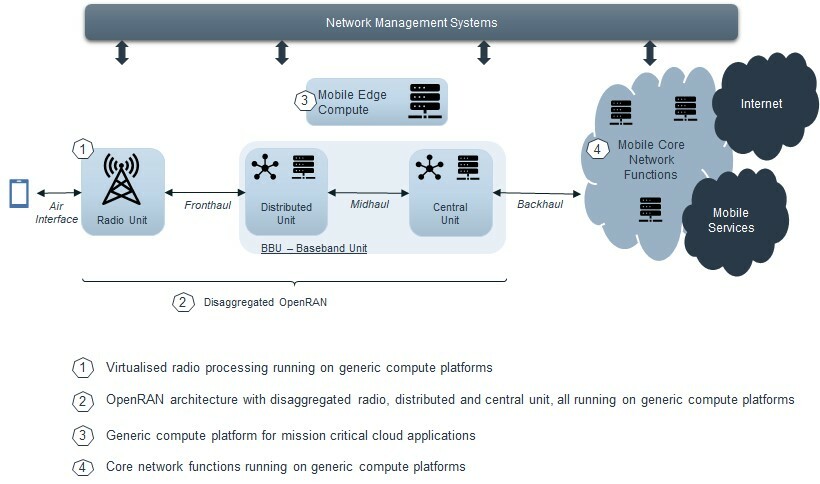
The future of UK 5G: Making the nation a leader in telecoms
In July, the UK government announced its decision to remove Huawei equipment from UK 5G networks by 2027. As it takes about three years to swap out base stations, the industry now has until 2024 to decide how to move forward.
This key decision has come at an important stage in the evolution of telecom equipment that’s ripe for disruptive innovation. Virtualisation, open interfaces and multi-access edge computing offer opportunities to transform how 5G networks will look, opening the door for new market entrants and business models. And now, the UK can be at the forefront of this change.
Virtualisation and multi-access edge computing can make 5G more cost-effective
Real-time processing of radio signals from antennae in base stations is essential to avoiding call disruptions. To date, this has happened through bespoke software running on costly bespoke hardware, creating a closed ecosystem of highly specialised telecom equipment vendors. Now, the computing power and speed of standard cloud hardware makes Network Function Virtualisation (NFV), Software Defined Networking (SDN) and Virtual Radio Access Networks (vRAN) possible. Such virtualisation lets mobile networks use standard hardware for multiple functions, offering significant cost and space savings.
These shared network solutions will be particularly useful for the roll-out of 5G. The new generation of mobile connectivity uses small cells deployed on lampposts. But lampposts at suitable locations are scarce, which means multiple operators need to share. Using virtualisation, a single set of equipment could provide the functions of several operators, making network provision up to 30 per cent more cost-effective.
This shared infrastructure could also run multi-access edge computing (MEC), which puts cloud servers nearer to base stations to minimise the distance data travels for processing. 5G offers low latencies in the mobile access network, which will be essential to advanced technology like autonomous vehicles and industrial robots, but the benefits of this will be lessened if the data needs to traverse long distances and several networks to reach cloud applications. MEC would solve this, and run on the same hardware as vRAN, unlocking the full potential of 5G low latency.
Furthering interoperable OpenRAN network solutions
To advance the adoption of such open and interoperable Radio Access Network (RAN) solutions, a consortium of companies formed OpenRAN. OpenRAN disaggregates the access networks into smaller parts: Radio Unit (RU), Distribution Unit (DU) and Central Unit (CU). This disaggregation makes it possible to tune the split of functions across each platform to operational needs. Together with the use of open interfaces, this allows a wider set of smaller suppliers to offer components for the access network while ensuring interoperability.
The illustration below shows this new architecture, from a person’s mobile phone on the left to the internet and cloud platforms on the right.

An expanding vendor landscape provides more equipment choice
This trend towards virtualisation and open interfaces has lowered entry barriers for new 5G-only entrants, such as Mavenir (US), Parallel Wireless (US), Altiostar (US), Airspan (US and UK) and others. At the same time, technology giants like Samsung Networks, NEC and Fujitsu are jumping on the bandwagon, with three South Korean and several American network operators already using Samsung’s 5G equipment. While the market is getting crowded, this rapid expansion in the equipment vendor landscape shows there’s potential for new UK-based vendors, particularly if they manage to identify new market niches.
Despite this wealth of equipment vendors, few mobile network operators have embraced OpenRAN – only two new greenfield mobile network operators are using OpenRAN equipment, Rakuten in Japan and Dish in the US. However, UK networks see potential in OpenRAN and have been running trials to understand its capabilities. A growing number of vendors with increasingly mature solutions can serve the UK, but established operators will wait before they risk existing business on them. So, it’s likely we’ll see adoption in niche areas of the network initially.
What does this mean for the UK?
In the past, the UK has always been at the forefront of innovation in telecoms because of its supportive regulation. Diversifying the telecom vendor supply chain while promoting open, interoperable, software-based solutions go hand-in-hand. The challenge for the UK now is to actively encourage this future. Doing so will create unprecedented opportunities to reduce costs, innovate, create new business models, stimulate existing businesses and open the market for new 5G entrants, including from the UK.
Explore more







